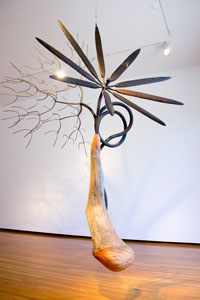Gallery Walk
James Surls at Arthur Roger
by Karl F. Volkmar, New Orleans Art Review

James Surls: Me, Tree, Black Flower, and Knot, 2006. Steel, pine, bass, 123” high.
The organic, monumental wood and steel sculptures of James Surls dominate the main gallery at Arthur Roger. Their massiveness is contrasted with weightlessness by their vertical suspension from the ceiling; even mounted on stands on the floor, they seem impossibly balanced. This defiance of gravity overcomes the heftiness and industry suggested by his use of chunks of mahogany and welded metal; they are simultaneously heavy and feather-light. In a video walk-through available on the gallery wcbsite, Surls further describes the duality of his sculptural forms. His shapes are connections of masculine and feminine, nature and industry, seed and growth.
In Standing Knife, Pinion, Morning Glory, from 2009, a steel skeleton of the morning glory blossom emerges from the handle of a giant wooden knife, poised on its tip. Root-like wires sprout from the opposite side of the knife handle, growing upward. In his walk-through, Surls uses this as an example of the union of the archetypal female vessel and the male phallus in his work. Strangely, one does not penetrate the other; rather, they grow from each other while creating new growth. This seems odder due to the violence that can be associated with his chosen images. The seeming violence of the sexual act is tempered with objects such as Me, Tree, Black Flower, and Knot, as well as other gigantic sculptures in the exhibition. They follow a similar formal pattern, but their shapes are more gently organic.
Slab Block with House, Shape, and Five Sticks creates a visual link to a series of graphite line drawings in the adjacent gallery. Slab Block is a smaller, horizontal wooden assemblage that forces the viewer to change his or her view and therefore interaction with the work. Situated on a small pedestal, the gaze is cast downward rather than up and around, and then face-to-face with intimately scaled, framed works on paper. With titles like Finding Time and compositions dominated by organic line and curvilinear shape, these seem like existential explorations inspired by Kandinsky. They are minimal in their means and phcnomenological in their depictions of human forms and varying perceptions of essences. Despite the contrast between medium and scale between the sculptures and drawings, they relate to each other by the forms of their compositions.
